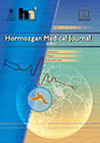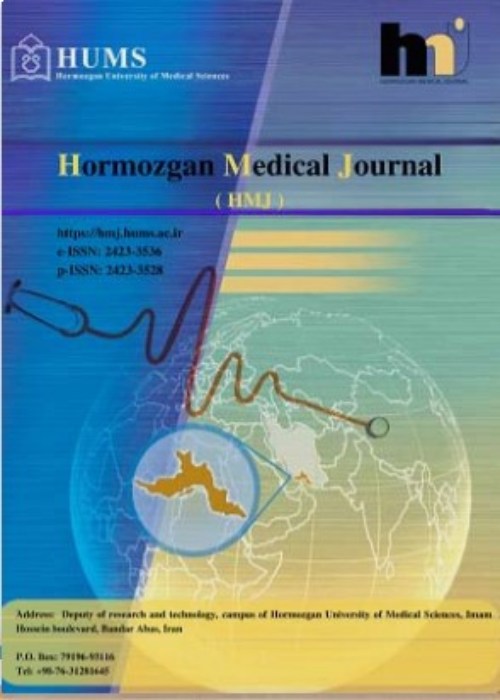فهرست مطالب

Hormozgan Medical Journal
Volume:24 Issue: 2, Jun 2020
- تاریخ انتشار: 1399/05/07
- تعداد عناوین: 8
-
-
Page 1Background
High blood pressure is known as a major risk factor for myocardial infarction and renal impairment. Various factors, including the pattern of food intake and physical activity, are effective in the incidence of hypertension.
ObjectivesThis study aimed at evaluating the relationship between dietary factors and hypertension in Hormozgan Province, South of Iran.
MethodsThis descriptive study was conducted on 5075 adults aged more than 18 years from Hormozgan in 2016. Samples were selected through cluster sampling and randomly. The subjects’ information, including demographic information, dietary intake, anthropometric status, and blood pressure, were collected.
ResultsThe high blood pressure in men was higher than in women. There was a significant relationship between systolic and diastolic blood pressure and age, body mass index, wrist and waist circumference, and waist-to-hip ratio. There was a statistically significant reverse relationship between hypertension and fruits intake, dairy products, fish, and decrease meat and nonalcoholic drink consumption.
ConclusionsRegarding the high prevalence of hypertension among people and its strong association with food intake, improving dietary patterns should be considered as an essential preventive action.
Keywords: Blood Pressure, Food Groups, Hypertension, Diet Pattern -
Page 2Background
A large number of nursing students work while studying to gain clinical experience, but there is not a standard tool to evaluate the clinical competence areas affected by working while studying.
ObjectivesThe current study aimed at explaining the role of clinical work while studying in the clinical competence of novice nurses and the development of a valid and reliable instrument to measure it.
MethodsThe current study employed an exploratory sequential mixed method design in two steps. First, qualitative research was conducted using conventional content analysis on 45 participants. The semi-structured, in-depth interviews (nurses, head nurses, and nurse managers) were performed, and data were analyzed using the eight steps of Elo and Kyngas. Second, based on the categories extracted from the first phase of the study and review of literature, 215 items were designed and analyzed in a methodological process.
ResultsThe results of the first phase consisted of three themes, including task rearing role, personality rearing role, and knowledge rearing role. Exploratory factor analysis leads to the formation of three factors: professional abilities with 18 items, individual abilities with seven items, and scientific and educational abilities with six items. Calculating Cronbach’s alpha coefficient confirmed high internal consistency in the scale (0.94).
ConclusionsThis tool could be used in teaching hospitals to evaluate the situation of working while studying in hospitals at different levels. With this tool, nursing managers can optimize educational environments and plan the workshops and training courses for nurses working in the departments in order to strengthen the qualifications of nursing students while working and graduating.
Keywords: Reliability Validity, Psychometric, Clinical Competence, Nursing Education, Clinical Activity, Instrumentation, Nurses -
Page 3Background
A sedentary lifestyle can result in chronic inflammation, which is a risk factor for Cardiovascular Disease (CVD). Lifestyle modifications, including physical activity and herbal supplements, may have health benefits.
ObjectivesThe present study aimed to investigate the effect of regular exercise and garlic consumption on some inflammatory biomarkers in sedentary overweight individuals.
MethodsForty-four sedentary overweight male participants (20 - 30 years) were randomized to the following groups: Exercise + garlic (ES), exercise + placebo (E), garlic (G), and placebo (P). The training protocol included 20 - 45 minutes of walking/running at 60 to 75% of the maximum heart rate, three sessions per week for eight weeks. Participants consumed two capsules containing 500 milligrams of garlic powder or placebo (starch) per day. Before and 48 h after the exercise intervention and supplement administration, blood samples were collected to assess the hs-CRP and TNF-α serum levels. One-way ANOVA and Tukey’s post hoc tests were used to analyze the data at a significance level of P < 0.05.
ResultsA significant difference was observed between the groups regarding the hs-CRP and TNF-α levels after the experimental period (P < 0.05). There was a significant difference between EG and placebo groups (P < 0.05).
ConclusionsBased on the findings, garlic consumption, along with exercise training could exert anti-inflammatory properties in overweight subjects.
Keywords: Inflammation, Garlic, Exercise, TNF-α, hs-CRP -
Page 4Background
Infertility is a universal problem with very limited scientific information relating to the factors that place men and women at risk of infertility.
ObjectivesTo determine the prevalence and risk factors of infertility in Bandar Abbas, a Southern port city of Iran.
MethodsWe conducted this cross-sectional study using a face-to-face questionnaire survey from September 2017 to March 2018 among 1,500 women at childbearing age.
ResultsData from 1469 valid questionnaires were finally assessed. There were 224 cases of current infertility with an incidence of 15.24% (95% CI, 14.79% - 15.44%), including 151 primary (10.27%; 95% CI, 10.09% - 11.14%) and 73 secondary (4.96%; 95% CI, 4.76% - 5.09%) infertilities. According to the univariate logistic regression analysis, age of men and women, women’s occupation, men engaged in high-temperature professions, age at marriage, menstrual cycle pattern, previous contraceptive usage, history of infertility in family, previous abortions, previous cesarean sections, number of pregnancies, previous vaginal delivery, smoking, physical activity, and BMI were significantly associated with infertility (all P ≤ 0.05). To determine the independent risk factors for infertility, multivariate logistic regression analysis was performed. Advanced age, heavy physical activity, obesity, men engaged in high-temperature professions, previous abortions, and previous cesarean sections were the risk factors for infertility. The number of pregnancies and previous vaginal deliveries were protective factors.
ConclusionsAlthough infertility risk factors are complex and multiple, and the investigated region does not represent all areas of Iran, the results can contribute to the overall reproductive health improvement among Iranians.
Keywords: Risk Factors, Iran, Infertility, Bandar Abbas -
Page 5Background
High-risk driving behaviors is one of the leading causes of death and disability.
ObjectivesThe aim of this study was to determine the effect of educational intervention on promoting safe-driving behaviors and reducing high risk-driving behaviors in taxi drivers based on the health belief model and planned behavior theory.
MethodsA quasi-experimental study of interventional and control drivers (n = 40) selected by a cluster sampling method was conducted. The participants were selected from taxi stations. The intervention group was divided into 4 groups, including 10 people. The contents of the training program were based on driving laws, avoiding high-risk behaviors, and advising on safe driving behaviors. The driving behaviors were measured at baseline and 3-month post-intervention. Constructs of the health belief model and theory of planned behavior were used as an interventional program framework. Independent t-test and Paired t-test were used to compare the scores between intervention and control drivers and the intervention group before and after the intervention at each of the variables, respectively.
ResultsThree months post-intervention, the scores of safe driving behaviors in the intervention group were higher than the control group, and high-risk driving behaviors in the intervention group were less than the control group. After the intervention, a significant difference was observed in the mean scores of perceived barriers, self-efficacy, cues to action, attitude, subjective norms, and perceived behavioral control between two groups (P < 0.05).
ConclusionsEducational intervention within the framework of the combined constructs of the health belief model and theory of planned behavior can reduce high-risk driving behaviors and promote safe driving behaviors in taxi drivers.
Keywords: Health Belief Model, Theory of Planned Behavior, Taxi Drivers, High-Risk Driving Behaviors, Safe Driving Behaviors -
Page 6Background
Obesity is a multi-factorial physical disorder that results in high serum lipid levels and glycemic disorders. On the other hand, regular exercise and administration of Eryngium Campestre (EC) have glucose and lipid-lowering effects.
ObjectivesThe present study aimed to review the effect of high-intensity interval training (HIIT) with EC on lipid profile and glycemic indices in high-fat diet (HFD)-induced obese rats.
MethodsTwenty-four obese rats were divided into four groups, including: (1) control, (2) HIIT, (3) EC, and (4) HIIT+EC. To investigate the effect of obesity on research variables, six rats were assigned to a healthy control group. During six weeks, groups 2 and 4 received HIIT three days per week, and groups 3 and 4 received 30 mg/kg EC by gavage. Data were analyzed using the Shapiro-Wilk test and one-way ANOVA with Tukey’s post hoc test (P ≤ 0.05).
ResultsObesity significantly increased cholesterol (Cho), triglyceride (TG), insulin, and glucose levels (P ≤ 0.05). However, HIIT significantly decreased Cho, TG, insulin, and glucose levels (P ≤ 0.05), and EC significantly decreased Cho, TG, low-density lipoprotein (LDL), insulin, and glucose levels (P ≤ 0.05). Besides, HIIT+EC significantly decreased LDL and insulin (P ≤ 0.05). HIIT+EC could decrease LDL more than did HIIT (P ≤ 0.05).
ConclusionsAlthough HIIT and EC alone improved the lipid profile and glycemic indices in obese rats, HIIT combined with EC had greater effects on the decrease of LDL compared to HIIT.
Keywords: Lipids, Glycemic Index, High-Intensity Interval Training, Eryngium -
Page 7Background
In Iran, most of the cleaning processes are performed manually in urban areas. Sweepers are exposed to respiratory pollutants, infectious substances, and other hazardous substances such as chemicals, animal feces, and sharp objects during improper disposal of waste. Respiratory pollutants in these occupations can cause inflammation and damage to the respiratory system. Moreover, prolonged exposure to respiratory pollutants in the workplace can reduce lung function and cause numerous health problems.
ObjectivesThis study aimed to examine the effect of workplace exposures of municipal solid waste collectors on the reduction of the pulmonary function level.
MethodsThis retrospective cohort study was performed on 198 municipal solid waste collectors aged 18 to 55 years who were employed in this profession for at least two years. The sampling method was census, and demographic data were extracted from occupational examination records.
ResultsExamining the relationship between pulmonary function decline and the studied variables showed a significant relationship between smoking and reduction of FVC, FEV1, and FEF25 -75. However, no significant relationship was observed between dust exposure and pulmonary function decline.
ConclusionsNo significant relationship was observed between pulmonary function loss and occupational dust exposure in municipal solid waste collectors. This means that the occupational exposure of these individuals was not severe enough to cause pulmonary function loss.
Keywords: Pulmonary Function, Spirometry, Municipal Solid Waste Collectors -
Page 8Introduction
Cardiac myxomas are the most common primary tumors of the heart with high embolic potential.
Case PresentationWe present a young man with progressing stroke and atrial myxoma in an unusual site from the left upper pulmonary vein.
ConclusionsIntravenous (IV) thrombolysis can be safe in patients with intracardiac myxoma and CNS embolization after good case selection. However, further studies are needed for better decision-making.
Keywords: Stroke, Thrombolysis, Cardiac Myxoma


